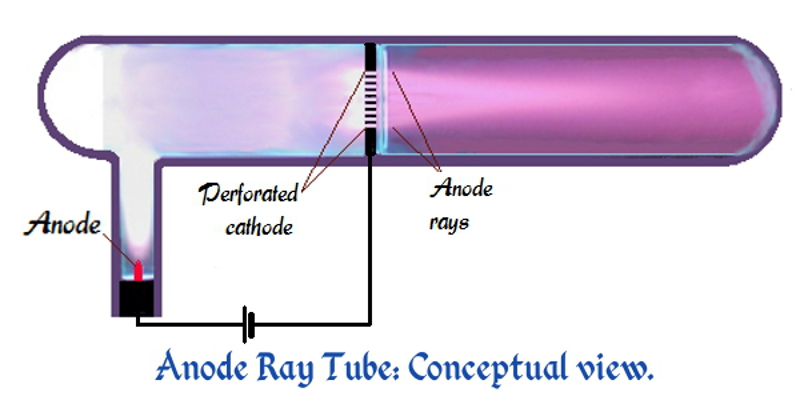Right, so a Proton Pack functions, basically, by generating a highly-energetic, directional stream of intense, charged alpha radiation -- i.e., high-energy protons at high speed.
If a cyclotron isn't a reasonable possibility, well, what is?
Let's break it down. We need a fairly prolific proton source, a way to focus and collimate them into a stream, and a way to energize and accelerate those protons to something extremely potent... and we need those things in approximately that order.
Proton source first. This is actually not as gnarly a problem as it might seem. In fact, it's solvable by a device related to something that, if you were reading this in the 1980s, would almost certainly be literally less than three feet from your face.
Remember CRT monitors? CRT stands for "Cathode Ray Tube".

An illustration from "High School Chemistry" (PDF), demonstrating the function of a Cathode Ray Tube. Image extracted by Wikimedia Project user 'Sharon Bewick'. (Original PDF Source, as hosted on Wikimedia Commons and uploaded by the CK-12 Foundation.)
The CRT is a descendant of an earlier tube called a Crookes Tube -- responsible also for the discovery of X-Rays (and, in fact, early X-Ray generating tubes were nothing more than specialized variants of the original Crookes Tube!). A Crookes Tube has a very complex operation inside because it involves plasma physics, and almost all of it is outside our interest and purview here. Suffice it to say that accurately describing everything going on in there is roughly akin to accurately describing exactly what's going on in Times Square for a randomly given ten minutes during an unusually busy New York City evening, omitting exactly zero detail.
We don't care.
We do care, however, about a very different descendant of that tube -- the much, much rarer "Why can't you be as accomplished as your brother" twin to the CRT, the anode ray tube.

Simple enough. I have... a couple ideas on how to make a convincing go at this. Some are more convincing than others. After all, this is a cosplay. It only has to look the part, it doesn't have to function -- a good thing, considering that the operational principles amount to more technobabble, in the common and traditional form of masculine bovid offal, than a bad episode of Star Trek: Voyager!
We then need some means of focusing and collimating -- aligning into roughly parallel beams or streams -- the protons and a further means of accelerating them. In particle physics, somewhat conveniently, the faster your particles are going, the more energetic they are, so a powerful enough accelerator will automatically energize our protons for us simply by getting them (literally) up to speed.
Collimation and focusing is a matter of magnetics. This will need to be controllable, obviously, so a whole pile of electromagnet looking stuff will be our friend here.
As for the accelerating gizmo -- I have a clever idea. It's... not common, but it's just as believable as the cyclotron on Peter Venkman's back, and with just about as few issues and problems. (Heh.) Take a linear accelerator and bend it into a spiral like a coil for a cheap electric stove.
The immediate problem with this is that, when you apply real-world physics to that, you get a coil that doesn't heat like a cheap electric stove, but more like something Bethlehem Steel would use to melt iron (and a few other things) into ingot, in the sort of size you'd expect of a $4 chair cushion from Wal*Mart! But this is a world where you can strap an eight-inch cyclotron to your back without having to put a three-foot diameter electromagnet on either side as well as a gigantic ferrite yoke that makes it roughly twice as heavy as the person trying to carry it! So we're going to ignore that pesky little issue and carry on right along.
So we know roughly what we're in for. Right, then, let's get to work!
 Starhawk
Starhawk
Discussions
Become a Hackaday.io Member
Create an account to leave a comment. Already have an account? Log In.